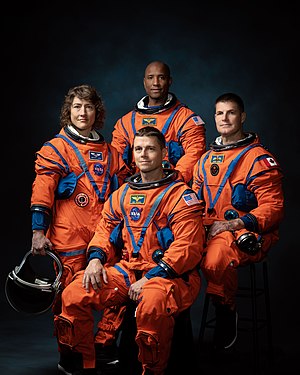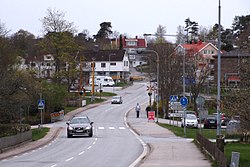아르테미스 2
Artemis 2 아르테미스 2 임무 계획 요약 | |
| 이름 | 아르테미스 2 탐사임무-2 (EM-2) |
|---|---|
| 임무유형 | 크루드 달 플라이바이 |
| 교환입니다. | 나사 |
| 임무기간 | 10일(예정) |
| 우주선 속성 | |
| 우주선 | 오리온 CM-003 |
| 크루 | |
| 승무원크기 | 4 |
| 회원들 | 리드 와이즈먼 빅터 글로버 크리스티나 코흐 제레미 한센 |
| 임무개시 | |
| 출시일자 | 2025년 9월(예정)[1] |
| 로켓 | SLS 블록 1 |
| 출시지 | 케네디 우주센터, LC-39B[2] |
| 청부업자 | 나사 |
| 임무 종료 | |
| 복구 대상자 | 미 해군 (샌안토니오급 수륙양용운반선 선착장) |
| 착륙장 | 태평양 (예정) |
| 플라이바이 오브 문 | |
| 거리 | 6,400 mi (10,300 km) (예정)[3] |
 공식 승무원 초상화 (왼쪽부터 시계방향) Koch, Glover, Hansen, Wiseman | |
아르테미스 2([4]Artemis II)는 미국 항공우주국(NASA)이 주도하는 아르테미스 프로그램의 예정된 임무입니다. 그것은 우주 발사 시스템 (SLS)의 두 번째 발사를 사용할 것이고 오리온 우주선의 첫 번째 승무원 임무를 포함할 것입니다. 임무는 늦어도 2025년 9월로 예정되어 있습니다.[1] 네 명의 우주 비행사들이 달의 근접 비행을 수행하고 지구로 돌아와 1972년 아폴로 17호 이후 지구의 낮은 궤도를 여행한 최초의 승무원이 될 것입니다. 아르테미스 2호는 2006년 STS-116 이후 케네디 우주 센터의 발사 단지 39B에서 발사되는 첫 번째 승무원 발사체가 될 것입니다.
원래 탐사 임무-2(EM-2)로 명명된 이 임무는 현재 취소된 로봇 소행성 재지정 임무에 의해 달 궤도에서 포착된 소행성에서 샘플을 수집하기 위한 것이었습니다.[5] 아르테미스 프로그램의 도입 이후 이름이 변경되었습니다.
역사
2017년, 탐사 미션-2는 우주 발사 시스템(SLS) 블록 1B의 단일 발사 임무로, 탐사 상부 단계, 달 블록 1 오리온 우주선, 50.7 t (55.9 쇼트톤, 112,000 lb)의 탑재체 삽입을 포함했습니다. 이 계획은 로봇 소행성 리다이렉트 미션에 의해 달 궤도에 배치된 소행성과 랑데부하여 우주 비행사들이 우주 유영을 수행하고 샘플을 수집하도록 하는 것이었습니다.[6] 2017년[7] 4월 소행성 리다이렉트 미션이 취소된 후, 4명의 우주 비행사로 구성된 승무원과 함께 8일간의 미션이 제안되어 달 주위를 자유롭게 돌아볼 수 있는 궤도로 보내졌습니다.[8] 2017년에 제안된 또 다른 제안은 딥 스페이스 게이트웨이의 첫 번째 요소를 전달하기 위해 4명의 우주 비행사를 오리온에 태우고 8일에서 21일 동안 달 주위를 도는 것이었습니다.[9] 2018년 3월, 더 강력한 탐색 상부 단계를 유지하기 위해 필요한 모바일 런처(Mobile Launcher) 제작이 지연됨에 따라 상업용 발사 차량에[10] 첫 번째 게이트웨이 모듈을 탑재하기로 결정했습니다.[11] 발사기는 Falcon Heavy로 선택되었습니다.[12]

2023년 2월 11일, NASA는 아르테미스 2 코어의 엔진 섹션을 수평으로 뒤집었습니다. 이는 차량의 나머지 부분과 일치하기 전에 마지막 주요 이정표였습니다. 3월 20일, 엔진 부분은 미초우드 조립 시설 103동에 있는 아르테미스 2 코어 스테이지와 짝을 이루었습니다. 나사는 엔진이 장착된 핵심 단계가 2023년 여름 케네디 우주센터에 전달될 것으로 예상했습니다.[13] 지난 5월 납기를 2023년 늦가을로 5개월 미뤘습니다.[14][15] 2024년 2월 현재에도 이런 일은 발생하지 않았습니다. 2023년[update] 9월 25일 현재 뉴올리언스 코어 스테이지에 장착된 RS-25 엔진의 일련번호는 E2047, E2059, E2062, E2063입니다.[16][17]
이 승무원은 2023년 4월 3일 NASA 관리자 빌 넬슨이 조 바이든 대통령의 FY2024 예산 제안에 대한 "State of NASA" 연설에서 언급한 대로 발표되었습니다.[18] 이 발표는 휴스턴 외곽의 엘링턴 필드에 있는 나사 시설에서 열린 특별한 행사에서 이루어졌습니다.[19] 그들은 2023년 3월 매드니스 챔피언십 경기를 위해 근처 NRG 경기장에 그날 늦게 나타났습니다.[20]
제안된 세컨더리 페이로드

NASA의 CubeSat Launch Initiative (CSLI)는 2019년에 Artemis 2 임무에 SLS에 탑승하여 CubeSat 임무를 2차 탑재체로 비행할 것을 미국 기관과 미국 기업에 제안했습니다.[21][22] NASA는 6단위(12kg, 26lb)와 12단위(20kg, 44lb) 큐브위성에 대한 제안을 모두 수락할 것입니다.[23] 아르테미스 1 임무와 마찬가지로 아르테미스 2호를 타고 비행하는 큐브위성은 SLS 상부와 오리온 우주선 사이의 스테이지 어댑터 링 안쪽에 장착될 예정이었으며, 오리온이 분리한 후 배치될 예정입니다.[23] 처음에는 2020년 2월까지 선정할 계획이었지만 2021년 10월 NASA는 임무에서 모든 2차 탑재체를 투하했습니다.[21][24]
출시일자
2011년 예비 검토 때는 2019년에서 2021년 사이에 출시일을 두었으나 이후에는 2023년으로 출시일을 미뤘습니다.[25][26] 2024년[update] 1월 현재, 이 임무는 빠르면 2025년 9월에 시작될 것으로 예상됩니다.[1]
크루
| 위치 | 우주비행사 | |
|---|---|---|
| 사령관 | 두번째 우주비행 | |
| 파일럿 | 두번째 우주비행 | |
| 미션 스페셜리스트 | 크리스티나 코흐( 두번째 우주비행 | |
| 미션 스페셜리스트 | 첫 우주비행 | |

아르테미스 2호는 4명의 우주인이 탑승할 예정입니다. 사령관 리드 와이즈먼, 조종사 빅터 J. 글로버, 임무 전문가 크리스티나 코흐, 임무 전문가 제레미 한센.[27] 제니 시디 기번스는 한센의 백업입니다. 만약 한센이 할 수 없다면 그녀는 임무에 참여할 것입니다.[28][29]
글로버, 코흐, 한센은 각각 유색인종, 여성, 그리고 비미국인으로서 지구의 낮은 궤도를 통과한 첫 번째 사람이 될 것입니다.[27] Hansen과 Sidey-Gibbons는 캐나다 사람이고 캐나다 우주국에 의해 할당되었습니다.[27] 2020년 미국과 캐나다 간의 조약으로 인해 그들이 참여하게 되었습니다.[30]
미션
아르테미스 2 임무 계획은 첫 번째 승무원 오리온 MPCV 우주선에 탑승한 4명의 우주인을 우주 발사 시스템의 블록 1 변형을 사용하여 최대 21일 동안 달의 근접 비행에 보내는 것입니다. 임무 프로파일은 다중 초달 주입(MTLI) 또는 다중 이탈 화상이며 달로부터의 자유 귀환 궤적을 포함합니다. 오리온 우주선은 약 24시간의 주기로 높은 지구 궤도로 보내질 예정입니다. 이 기간 동안 승무원들은 우주선의 생명 유지 시스템에 대한 다양한 점검과 함께 사용 후 ICPS(Interimal Cryogenic Propulsion Stage)를 표적으로 사용하여 우주 랑데부 및 근접 작전 시연을 수행합니다. 오리온은 다시 한 번 근일점에 도달하면 주 엔진을 발사해 달 자유 귀환 궤도로 보내는 TLI 기동을 완료한 뒤 지구로 귀환할 예정입니다.[3][31]
광통신
아르테미스 2호는 오리온 아르테미스 II 광통신 시스템(O2O)을 이용해 지구와 오가는 광통신을 시험하고 시연할 예정입니다.[32] O2O 하드웨어는 오리온 우주선에 통합되며 광학 모듈(4인치 [100mm] 망원경과 2개의 짐벌), 모뎀 및 제어 전자 장치가 포함됩니다.[32] O2O는 캘리포니아와 뉴멕시코에 있는 지상국과 통신할 것입니다.[32] 이 테스트 장치는 초당 최대 260메가비트의 다운링크 속도로 데이터를 지구로 전송합니다.[33]
유사임무
플라이드
1968년 12월, 우주비행사 프랭크 보먼, 짐 로벨, 윌리엄 앤더스가 승무원으로 탑승한 아폴로 8호는 지구의 낮은 궤도 너머로 명령과 서비스 모듈을 날렸고 달의 10번의 궤도를 완료했습니다. 계획된 아르테미스 2 미션과 유사하게 승무원이 탑승해 착륙하지 않는 방식으로 궤도에 안착하는 방식으로 차이를 보였습니다.[34] 아폴로 13호(1970)는 달을 지나 자유 귀환 궤도로 비행한 유일한 아폴로 임무였습니다.
제안서
2005년, Space Adventures라는 회사는 전문 우주 비행사가 조종하는 소유스 우주선을 이용하여 달 표면으로부터 100 km(62 mi) 이내에 두 명의 관광객을 데려가는 달 관광 임무 계획을 발표했습니다. DSE-Alpha로 명명된 이 임무는 좌석당 가격이 1억 5천만 달러에 달하며 예정대로라면 8-9일간 지속될 것으로 예상됩니다. 에릭 앤더슨 CEO는 2011년 한 자리가 팔렸다고 밝혔으나 2017년[update] 현재 두 번째 자리가 팔리지 않아 출시일이 계속 미끄러지고 있습니다.[35]
스페이스X 달 관광 임무는 2018년 말에 처음 제안되었으며 승무원 규모가 아르테미스 2와 비슷했을 것이며, 두 명의 우주 관광객이 크루 드래곤 캡슐을 사용하여 달 주위를 돌고 지구로 돌아가는 자유 귀환 루프에 비용을 지불하고 팰콘 헤비에 발사되었습니다.[36][37] 2018년 Falcon Heavy의 첫 비행 후 SpaceX는 Falcon Heavy가 향후 개발을 스타쉽에 집중하기 위해 승무원 비행에 사용되지 않을 것이라고 발표하고 달 임무가 스타쉽과 함께 수행될 가능성이 더 높다고 밝혔습니다.[38][39] 2018년 9월 14일, 스페이스 엑스는 스타쉽을 이용한 디어 문 프로젝트 미션을 위해 유료 승객 중 한 명인 마에자와 유사쿠와 계약을 체결했으며 6~8명의 아티스트를 초대할 것이라고 공식 발표했습니다.[40][41]
참고문헌
- ^ a b c Foust, Jeff (9 January 2024). "NASA delays Artemis 2 and 3 missions". SpaceNews. Retrieved 10 January 2024.
- ^ Hill, Bill (March 2012). "Exploration Systems Development Status" (PDF). NASA Advisory Council. Archived from the original on 11 February 2017. Retrieved 21 July 2012.
 이 문서에는 공개 도메인에 있는 이 출처의 텍스트가 포함되어 있습니다.
이 문서에는 공개 도메인에 있는 이 출처의 텍스트가 포함되어 있습니다. - ^ a b Hambleton, Kathryn (27 August 2018). "First Flight With Crew Important Step on Long-Term Return to Moon". NASA. Archived from the original on 30 August 2018. Retrieved 6 April 2023.
- ^ Artemis: brand book (Report). Washington, D.C.: National Aeronautics and Space Administration. 2019. NP-2019-07-2735-HQ.
MISSION NAMING CONVENTION. While Apollo mission patches used numbers and Roman numerals throughout the program, Artemis mission names will use a Roman numeral convention.
 이 문서에는 공개 도메인에 있는 이 출처의 텍스트가 포함되어 있습니다.
이 문서에는 공개 도메인에 있는 이 출처의 텍스트가 포함되어 있습니다. - ^ Foust, Jeff (25 March 2015). "NASA Selects Boulder Option for Asteroid Redirect Mission". SpaceNews. Archived from the original on 7 October 2023. Retrieved 27 March 2015.
- ^ Wall, Mike (10 April 2013). "Inside NASA's Plan to Catch an Asteroid (Bruce Willis Not Required)". Space.com. Archived from the original on 1 August 2019. Retrieved 10 April 2013.
- ^ Foust, Jeff (14 June 2017). "NASA closing out Asteroid Redirect Mission". SpaceNews. Archived from the original on 15 June 2017. Retrieved 9 September 2017.
- ^ Hambleton, Kathryn (4 August 2017). "NASA's First Flight With Crew Will Mark Important Step on Journey to Mars". NASA. Archived from the original on 28 July 2020. Retrieved 8 December 2017.
 이 문서에는 공개 도메인에 있는 이 출처의 텍스트가 포함되어 있습니다.
이 문서에는 공개 도메인에 있는 이 출처의 텍스트가 포함되어 있습니다. - ^ Gebhardt, Chris (6 April 2017). "NASA finally sets goals, missions for SLS – eyes multi-step plan to Mars". NASASpaceflight.com. Archived from the original on 21 August 2017. Retrieved 3 May 2017.
- ^ "NASA FY 2019 Budget Overview" (PDF). NASA. p. 14. Archived (PDF) from the original on 4 December 2019. Retrieved 12 November 2021.
Supports launch of the Power and Propulsion Element on a commercial launch vehicle as the first component of the LOP - Gateway
 이 문서에는 공개 도메인에 있는 이 출처의 텍스트가 포함되어 있습니다.
이 문서에는 공개 도메인에 있는 이 출처의 텍스트가 포함되어 있습니다. - ^ Berger, Eric (13 April 2018). "NASA may fly crew into deep space sooner, but there's a price". Ars Technica. Archived from the original on 26 October 2019. Retrieved 6 April 2023.
Without the Exploration Upper Stage, NASA will not be able to fly, in a single flight, crew members and pieces of a deep space gateway it hopes to build near the Moon in the 2020s
- ^ Foust, Jeff (10 February 2021). "NASA selects Falcon Heavy to launch first Gateway elements". SpaceNews. Archived from the original on 7 October 2023. Retrieved 4 September 2022.
- ^ Richardson, Derek (23 March 2023). "Artemis 2 Space Launch System core stage nearly complete". SpaceFlight Insider. Archived from the original on 31 March 2023. Retrieved 31 March 2023.
- ^ Clark, Stephen (29 September 2023). "Rocket Report: Iran launches satellite; Artemis II boosters get train ride". Ars Technica. Archived from the original on 29 September 2023. Retrieved 2 October 2023.
- ^ Sloss, Philip (2 May 2023). "Artemis II Moon mission transitioning from planning to preparation". NASASpaceFlight.com. Archived from the original on 2 May 2023. Retrieved 6 June 2023.
- ^ Mohon, Lee; O'Brien, Kevin (27 October 2022). "Space Launch System Engines: Launching Artemis Astronauts to the Moon". NASA. Archived from the original on 26 June 2023. Retrieved 26 June 2023.
- ^ Mohon, Lee (25 September 2023). "All Engines Added to NASA's Artemis II Moon Rocket Core Stage – Artemis". NASA Blogs. Archived from the original on 25 September 2023. Retrieved 25 September 2023.
- ^ Foust, Jeff (9 March 2023). "White House proposes $27.2 billion for NASA in 2024". SpaceNews. Archived from the original on 7 October 2023. Retrieved 10 March 2023.
- ^ Pearlman, Robert Z. (3 April 2023). "NASA Announces the Astronaut Crew for Artemis II Lunar Flyby". Scientific American. Archived from the original on 3 April 2023. Retrieved 3 April 2023.
- ^ Koch, Christina (11 April 2023). "You stood. All of you. You stood for taking on the challenge. For doing things that are hard. For exploring together. Of all the things we did last week to introduce Artemis II, this unexpected standing ovation was the moment I realized—You're all behind this. We are going". Twitter. Retrieved 13 April 2023.
- ^ a b Hill, Denise (6 August 2019). "NASA's CubeSat Launch Initiative Opens Call for Payloads on Artemis 2 Mission". NASA. Archived from the original on 6 August 2019. Retrieved 6 August 2019.
NASA is seeking proposals from U.S. small satellite developers to fly their CubeSat missions as secondary payloads aboard the SLS on the Artemis 2 mission under the agency's CubeSat Launch Initiative (CSLI)
 이 문서에는 공개 도메인에 있는 이 출처의 텍스트가 포함되어 있습니다.
이 문서에는 공개 도메인에 있는 이 출처의 텍스트가 포함되어 있습니다. - ^ Klotz, Irene (5 August 2019). "NASA Scouting Cubesats For Artemis-2 Mission". Aviation Week & Space Technology. Archived from the original on 6 August 2019. Retrieved 6 August 2019.
NASA on August 5 released a solicitation for cubesats to ride along with the first crewed flight of the Space Launch System rocket and Orion capsule, with the caveat that selected projects fill strategic knowledge gaps for future lunar and Mars exploration
- ^ a b Foust, Jeff (8 August 2019). "NASA seeking proposals for cubesats on second SLS launch". SpaceNews. Archived from the original on 15 May 2023. Retrieved 6 April 2023.
- ^ Kurkowski, Seth (21 October 2021). "Alabama students forced to pivot satellite design after being dropped from Artemis II". Space Explored. Archived from the original on 21 October 2021. Retrieved 13 December 2021.
- ^ Hambleton, Kathryn (8 March 2019). "NASA's Deep Space Exploration System is Coming Together". NASA. Archived from the original on 1 August 2019. Retrieved 10 March 2019.
 이 문서에는 공개 도메인에 있는 이 출처의 텍스트가 포함되어 있습니다.
이 문서에는 공개 도메인에 있는 이 출처의 텍스트가 포함되어 있습니다. - ^ Sloss, Philip (28 December 2018). "Crewed Orion spacecraft passes critical design review". NASASpaceFlight.com. Archived from the original on 16 February 2019. Retrieved 9 March 2019.
- ^ a b c
- O'Shea, Claire (3 April 2023). "NASA Names Astronauts to Next Moon Mission, First Crew Under Artemis". NASA. Archived from the original on 22 July 2023. Retrieved 9 August 2023.
- Wall, Mike (3 April 2023). "Meet the 4 astronauts flying on NASA's Artemis 2 moon mission". Space.com. Archived from the original on 29 May 2023. Retrieved 9 August 2023.
- Wattles, Jackie; Strickland, Ashley (3 April 2023). "The four astronauts NASA picked for the first crewed moon mission in 50 years". CNN. Archived from the original on 10 August 2023. Retrieved 9 August 2023.
- Stamm, Amy. "Meet the Crew of Artemis II". airandspace.si.edu. Archived from the original on 8 April 2023. Retrieved 9 August 2023.
- ^ "Canadian Space Agency astronauts Jenni Gibbons and Joshua Kutryk to contribute to future missions, from the International Space Station to the Moon". Cision. Longueuil, Quebec. CNW Group. 22 November 2023. Retrieved 22 November 2023.
- ^ Nassar, Hana Mae (22 November 2023). "Canadian astronauts receive new assignments". CityNews. Vancouver. Archived from the original on 22 November 2023. Retrieved 22 November 2023.
- ^ Connolly, Amanda (16 December 2020). "A Canadian astronaut will be on NASA's Artemis deep space lunar orbit as well the first non American to leave earth orbit". Global News. Archived from the original on 16 December 2020. Retrieved 16 December 2020.
- ^ Sloss, Philip (25 June 2020). "NASA studying practice rendezvous options for Artemis 2 Orion". NASASpaceFlight.com. Archived from the original on 27 June 2021. Retrieved 27 June 2021.
- ^ a b c Murphy, Kendall (3 June 2021). "Lasers Light the Way for Artemis II Moon Mission". Exploration and Space Communications. NASA. Archived from the original on 3 June 2021. Retrieved 6 April 2023.
- ^ Schauer, Katherine (11 August 2022). "What's Next: The Future of NASA's Laser Communications". NASA. Archived from the original on 3 March 2023.
- ^ Wood, Charlie (25 February 2017). "Apollo 8 redux: Why NASA may send humans around the Moon, again". The Christian Science Monitor. Archived from the original on 4 March 2017. Retrieved 4 March 2017.
- ^ Moseman, Andrew (26 April 2011). "Just One US$150 Million Seat Remains on Space Adventures' Lunar Flyby". Popular Mechanics. Archived from the original on 18 October 2016. Retrieved 4 June 2017.
- ^ Grush, Loren (3 March 2017). "SpaceX promises a Moon vacation in 2018". The Verge. Archived from the original on 3 March 2017. Retrieved 4 March 2017 – via YouTube.
- ^ Trumbore, Dave (27 February 2017). "SpaceX Will Attempt to Send Humans Around the Moon Next Year". Nerdist. Archived from the original on 5 March 2017. Retrieved 4 March 2017.
- ^ Foust, Jeff (6 February 2018). "SpaceX no longer planning crewed missions on Falcon Heavy". SpaceNews. Archived from the original on 20 February 2022. Retrieved 6 April 2023.
- ^ Pasztor, Andy (6 February 2018). "Elon Musk Says SpaceX's New Falcon Heavy Rocket Unlikely to Carry Astronauts". The Wall Street Journal. Archived from the original on 6 February 2018. Retrieved 6 February 2018.
- ^ Ralph, Eric (14 September 2018). "SpaceX has signed a private passenger for the first BFR launch around the Moon". Teslarati. Archived from the original on 14 September 2018. Retrieved 14 September 2018.
- ^ Grush, Loren (14 September 2018). "SpaceX says it will send someone around the Moon on its future monster rocket". The Verge. Archived from the original on 14 September 2018. Retrieved 15 September 2018.




